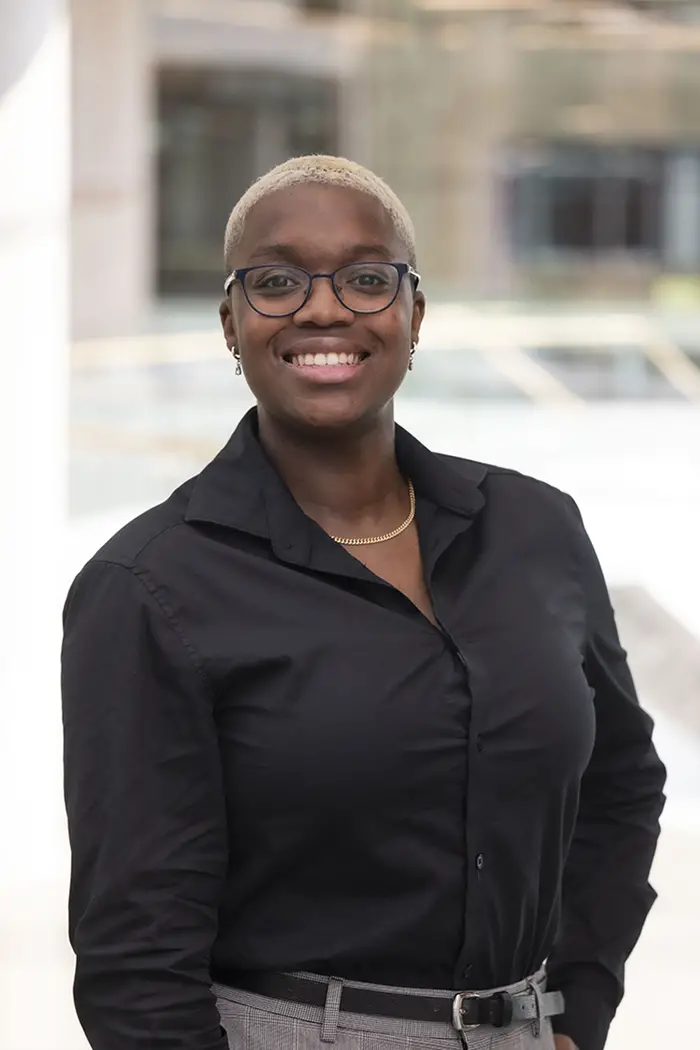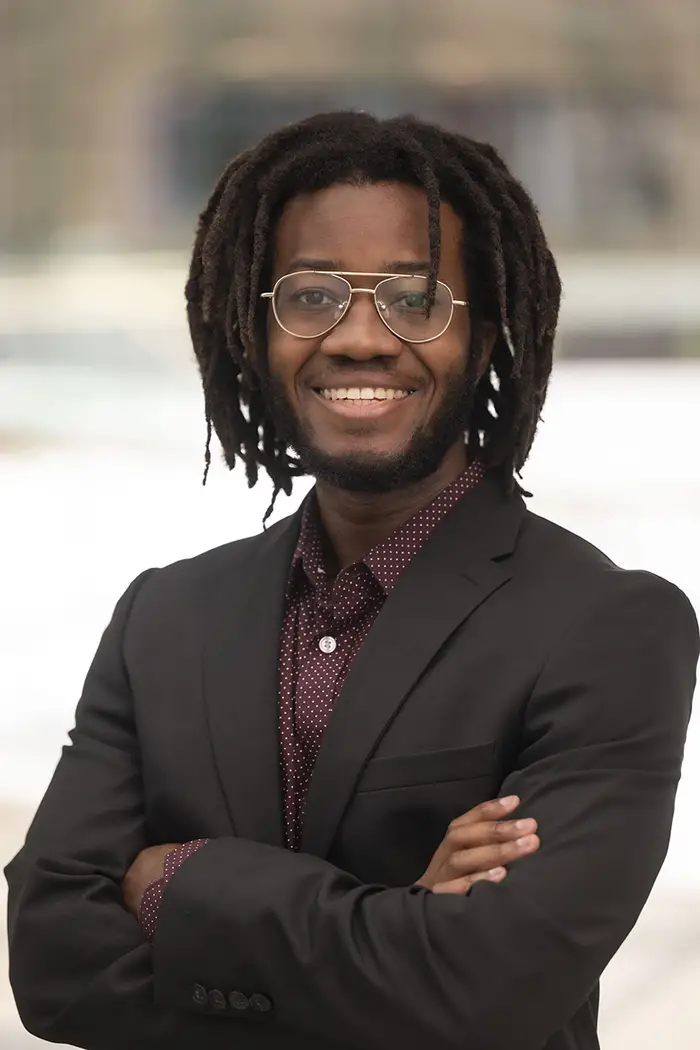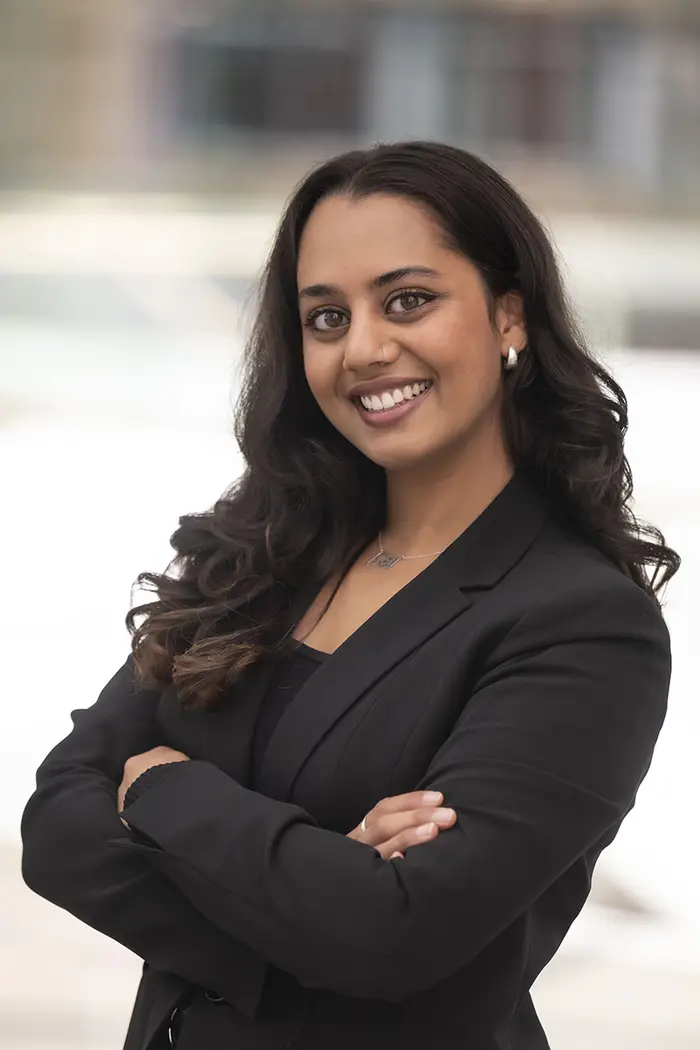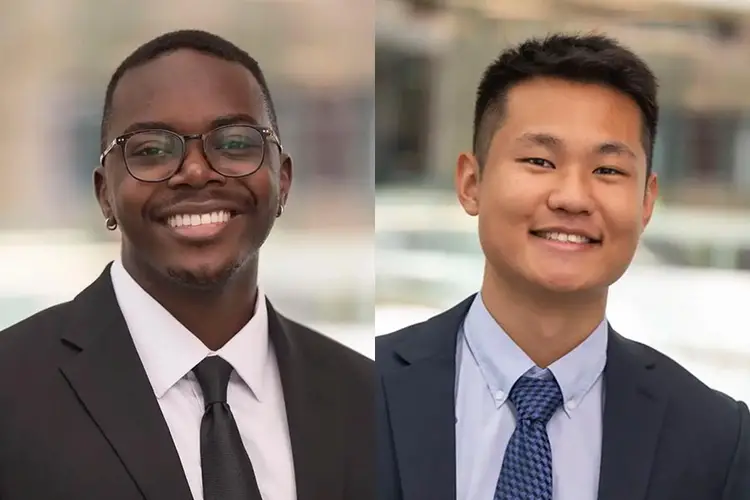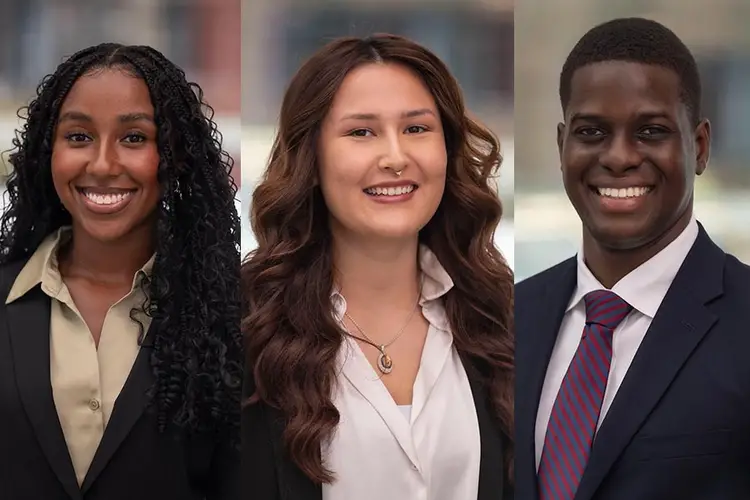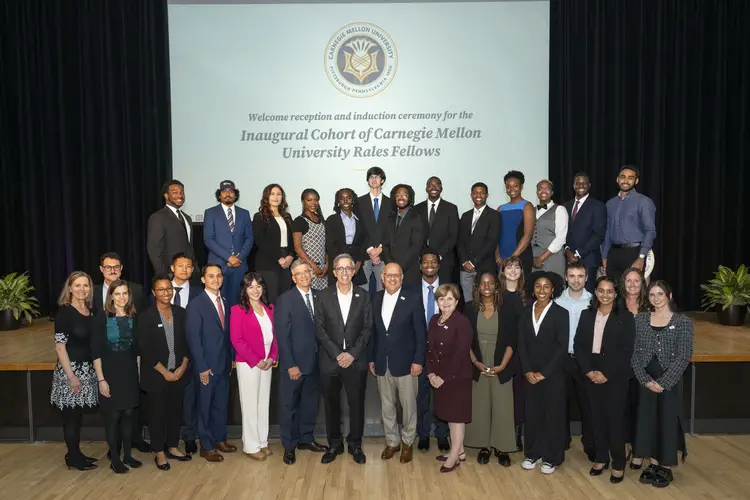Spirit of Discovery Motivates Rales Fellows at Confluences of Research Fields
Media Inquiries
Three first-year master’s degree students chosen as part of the inaugural cohort of the Carnegie Mellon University Rales Fellows Program(opens in new window) saw opportunities for research and innovation where traditional fields meet.
Their work aims to pioneer 3D printing techniques that can aid in disaster relief, explore new battery materials to contribute to decarbonization technologies, and apply machine learning techniques to accelerate drug testing and discovery.
Cameron Drewery(opens in new window), Nisha Shah(opens in new window) and Nathan Odonkor(opens in new window) are among a class of 22(opens in new window) pursuing graduate degrees at Carnegie Mellon through the Rales Fellows Program. Launched in 2023(opens in new window), the program is dedicated to cultivating the next generation of science, technology, engineering and math (STEM) leaders while also increasing access to graduate-level education.
Cameron Drewery aspires to use 3D printing for disaster relief
As a Hurricane Katrina survivor originally from Baton Rouge, Louisiana, Drewery recognized an opportunity to use her knowledge and future research in additive manufacturing to help families in coastal areas that are repeatedly subjected to heavy storms.
“I’ll still see roofs that have tarps on them from hurricanes that happened years and years ago,” she said.
While earning her bachelor’s degree in mechanical engineering from Howard University, Drewery spent a summer as an undergraduate researcher at Florida International University that solidified her interest in applications for the industrial process.
She used a digital light processing 3D printer that combined resin with tantalum carbide, a ceramic compound, to create a small rocket nozzle. Even though it was about half the size of a person’s index finger and it took all day to print, Drewery said it inspired her to dig deeper.
“If we're able to 3D print ceramics using a variety of additive manufacturing methods, then we can print very complex geometries that could be manufactured,” Drewery said.
New innovations are already using additive manufacturing to 3D print houses using concrete(opens in new window) but have not yet been applied to portions of existing buildings, she said.
“Why not bring that to the communities that are being battered over and over and over by these storms?” Drewery said. “That way these families don’t have to start over every time a storm hits.”
Structural components could be recreated to replace shingles or reinforce roofs, she said.
“I want to know if we can use ceramics and metals to print composite materials on exteriors of structures in hurricane-bound or tornado-bound areas to protect from projectiles and debris in high-wind environments or from flooding damaged homes,” she said. “Maybe we can strengthen these homes or improve the overall structural integrity of them.”
When searching for ways to contribute to future innovations by gaining more focused experience in the field, Drewery realized Carnegie Mellon is one of the few universities with a master’s degree program in additive manufacturing(opens in new window).
“With climate change, these storms are only getting more intense and we’re seeing a rise in newly constructed homes, but they’re all being constructed out of the same things they were 20 years ago,” she said. “The possibilities are endless. If I can be a pioneer in the industry, that’s something that I would love to do.”
After her participation in the fourth cohort of the Karsh STEM Scholars(opens in new window) at Howard, Drewery said she appreciated the similarities between that program and the Rales Fellows Program, including mentoring and advising.
Combining those specific resources with the others available at Carnegie Mellon, “make it a luxury to be a student,” she said. “There's no financial barrier, there's no administrative barrier, no academic barrier. Everything you need is right here.”
Nathan Odonkor aims to develop algorithms for drug discovery
While earning his undergraduate degree in biomedical engineering at Georgia Tech, Odonkor mainly focused on the development of medical devices.
“I’ve always had an ache to understand things, and as I got into biology, I saw how the smaller you go, the more complicated things get, just like the world’s greatest puzzle,” he said.
After graduation, he decided to go a different direction, working in the biotech industry for three years in Boston.
He found rewarding work related to CAR T-cell therapy, a type of cancer immunotherapy, developing immunological assays.
“It was exciting working in a new city and field, but I wanted to try something new and expand my career option,” he said. “I fell in love with the concept of drug discovery and development, so that’s what motivated me to apply for Carnegie Mellon’s combined program.”
Now, as a student in the program led jointly by the Ray and Stephanie Lane Computational Biology Department(opens in new window) in the School of Computer Science(opens in new window) and Department of Biological Sciences(opens in new window) in the Mellon College of Science(opens in new window), Odonkor is working to develop algorithms for drug development.
Working through the Joint CMU-Pitt Ph.D. Program in Computational Biology(opens in new window), Odonkor said his research work in David Ryan Koes’ lab at the University of Pittsburgh has been a good fit, as its focus is also on democratizing science.
Specifically, Odonkor is working with a protein pocket similarity comparator. A protein's function depends on its amino acid composition, which creates specific binding sites with the shape, charge and chemical properties needed to perform its function, Odonkor explained.
“What we’re studying is: How can we assess protein binding pocket similarity in order to support structure-based drug development?” he said. “This is relevant to drug development because identifying similar protein binding pockets helps enable the repurposing of existing drugs and aids in the prediction of off-target effects.”
Odonkor said Carnegie Mellon’s pioneering influence and leading reputation as the main reasons he wanted to study and research at CMU.
“Given Carnegie Mellon's reputation in terms of computer science, I wanted to learn about developing algorithms and machine learning techniques that I could apply in the drug discovery space to rapidly accelerate the rate at which we’re able to identify therapeutic proteins,” he said.
So far, he’s also had introductory training at the Future of Engineering and Science Automation Initiative(opens in new window) in Bakery Square that he hopes he can harness in the future, calling the experience “insightful” helping him in “realizing how to leverage automation for high throughput experiments.”
Even when he’s up working till 4 a.m. — “because I was jazzed, I was having a good time,” he said — Odonkor makes time to serve as social chair on the executive board of the Black Graduate Student Organization(opens in new window), play cello in the chamber orchestra(opens in new window) and grow plants in his apartment he hopes to one day cultivate in a community garden.
“In everything I do,” Odonkor said, “I want it to be a self-perpetuating machine of creativity, growing community and inclusiveness.”
Nisha Shah hopes to make better batteries more sustainable
After graduating from the University of Pennsylvania with an undergraduate degree in materials science, Shah found out about the Rales Fellows Program when she was applying for jobs and master’s degree programs at the same time.
Shah first developed her interest in materials science taking chemistry courses, wanting to apply what she was learning to decarbonization technologies, which include renewable energy systems and sustainable transportation.
“I found myself most interested in working at the cell level of batteries,” she said. “If you think of a Tesla (electric car), you’ve got to pack a bunch of really small, cylindrical cells all stacked up in series, in parallel, and they build up a high-powered battery pack. Each of the individual cells are made of many different materials in contact with each other in varying forms and geometries, so the cells themselves have really interesting materials challenges.”
During her undergraduate degree, she interned at Vermont-based electric aviation startup Beta Technologies. Combining that experience with her introductory electrochemistry and renewable energy materials courses, Shah said the field came more into focus for her.
"I want to apply my engineering background to a career developing higher-performance battery cells,” she said. “I saw firsthand the efforts exerted by my colleagues to design around the safety and performance limitations of externally sourced cells. The introductory electrochemistry and renewable energy materials courses I’ve taken have reinforced this desire."
Now, she’s doing research with the Whitacre Research Group(opens in new window), led by Jay F. Whitacre(opens in new window), a Trustee Professor in Energy, Engineering and Public Policy with the CMU College of Engineering(opens in new window), who also formerly served as the materials science and engineering director of Wilton E. Scott Institute for Energy Innovation(opens in new window).
The lab works on materials and energy policy for electrochemical energy storage and generation. Specifically, Shah focuses on cobalt-free cathode materials in order to make more environmentally sustainable batteries instead of relying on the mined metal, she said.
“Taking cobalt out of the battery material while still trying to maintain cost and the same sort of performance characteristics are really important for battery development,” Shah said. “Batteries have really interesting materials challenges, because they are a stack of several different materials where all their transport and charge mechanisms interplay.”
In addition to joining Tartan Salsa(opens in new window), Shah said she’s been enjoying exercise classes(opens in new window) on CMU’s campus and otherwise exploring Pittsburgh. She also volunteered with the Girls Advancing in STEM(opens in new window) conference in November, and she wants to be sure she’s making a positive difference through outreach.
“I want what I do to have an impact on others or the climate in order to keep my motivation going,” she said.
Rales resources build cohort community
Drewery said so far she has enjoyed events that have helped the Rales fellows build a community outside of the classroom.
“I think the Rales staff did an amazing job picking a cohort that would mesh very well together from various demographic and academic backgrounds,” she said. “While this is still an academic program, we also find the value in hanging out in nonacademic settings.”
Shah said she has enjoyed the Rales Fellows Gathering Space(opens in new window), a community space featuring a kitchenette, lounge and conference rooms, in the WQED building on Fifth Avenue.
“Having that as a stopping place in between the day, a place to get work done, or just sit and chat with the other fellows — school is stressful, there’s so much to do, but when you’re able to just sit together and work — those little moments have been the best ones to get to know the cohort a little deeper,” she said.
Even the digital community via the fellows’ group chat has been a welcome resource, Odonkor said. He’s enjoyed a book club some of the fellows have formed, and other informal get-togethers, such as grocery trips.
“We really got to know each other before the school year even started,” he said. “It makes you feel comfortable and that’s really important. It’s been great.”
Ultimately, the others agreed with Drewery, who said she is grateful for the CMU Rales Fellows Program, especially the guidance and assistance of its staff.
“Everyone here is interested in the well-being of the students,” she said.
